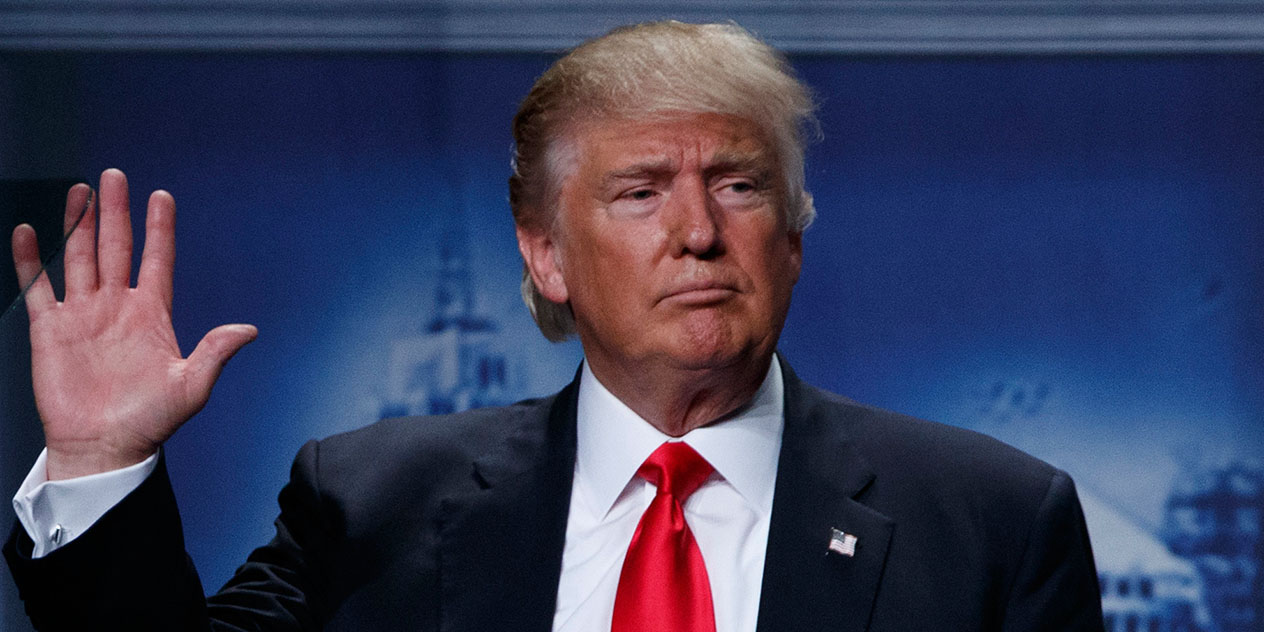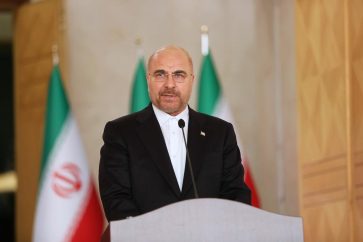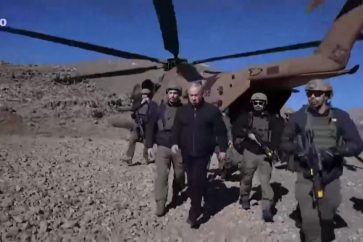President Trump, inspired by TV images of faraway suffering to launch missile strikes against Syria, may be about to discover a lesson that has confounded presidents for 25 years: American power can only do so much.
That truth is also embedded in another set of disturbing images that Mr. Trump has not cited publicly: those from Nigeria’s conflict-torn northeast, where a very different crisis is drawing different American action toward different ends.
Those two conflicts, in both their contrasts and commonalities, reveal something of the role that Mr. Trump has taken on and its limitation.
Both are humanitarian disasters whose ground-level stories horrify and enrage. And they are both crises of a sort that the United States, since emerging from the Cold War as the world’s policeman, has repeatedly tried but often failed to resolve.
The range of American intervention efforts, as well as their often modest success, can be seen in those two crises that Mr. Trump inherited: Syria, whose civil war has become a global issue, and Nigeria, where fighting with Boko Haram rebels has killed tens of thousands and displaced an estimated three million people.
Syria and Nigeria
The two wars could hardly be more different, as are the American responses. Yet they may still share the fundamental dynamics that make conflict-driven crises so resistant to outside resolution.
In Syria, the United States has sought to either mediate between the warring parties or tip the military balance through force, whether by the Obama administration’s efforts to arm certain rebels or Mr. Trump’s missile strikes. The scope of the United States’ involvement has been extensive and highly visible.
In Nigeria, American action appears more modest.
There, the United States is emphasizing political tools, pressuring the government to improve practices in the affected parts of the country and supporting any reforms. It has helped to coordinate a multinational force from surrounding countries. It is also providing military advisers, intelligence and other forms of military support, which Mr. Trump this week extended in the form of warplane sales, but nothing comparable to action in Syria.
The difference between the two approaches is partly explained by the scale of the suffering, which is more severe in Syria, and perhaps by an even wider gap in attention received.
It is also explained by Syria’s wider geopolitical stakes — its conflict touches on the European refugee crisis, Russia’s resurgence, global terrorism and Middle Eastern power struggles — whereas Nigeria’s is contained to a region that is less central to American interests.
But the difference is also caused by the contrasting nature of the crises. Syria’s problem is seen, in part, as a deadlocked military imbalance that American force is meant to overturn. Nigeria’s problems are driven more by crises in governing.
Boko Haram has exploited, and been fueled by, long-held political tensions and grievances within Nigerian society, including neglect by the central government and abuse by its soldiers. American policy is aimed at helping Nigeria address the underlying issues that helped give rise to the insurgency, pushing for reforms to roll back corruption and military abuses.
Because the goal is restoring government control and local faith in it, military power plays a smaller role in American strategy.
Still, Americans sometimes see the degree of military intervention as a function of political will — if the president cared, he would intervene. This reveals a deeper assumption: that American power can solve any crisis, but only if it is sufficiently and correctly applied.
But while the United States has exerted far more effort in Syria than in Nigeria, and has used different tools, the outcomes have been similar to what it often finds in such efforts: disappointment.
Collapse and Intervention
The conflicts in Syria and Nigeria, in their breadth of difference, reveal the common factors that make conflict-driven humanitarian crises so hard to solve: simultaneous breakdowns in governing and in the social contract by which a population agrees to exist in harmony.
Once these have collapsed, segments of society, whether divided by demographic tribe or political affiliation, come to see one another as locked in a zero-sum contest for survival and control. The result is chaos, a self-perpetuating cycle of violence with entire communities caught in the middle.
Syria and Nigeria also illustrate a common American response: intervention, military or otherwise, to resolve the underlying political breakdown that compels the fighting.
Since the early 1990s, when the United States took on the mantle of global leadership, it has acted in Somalia, in Afghanistan, in two different parts of Sudan, in the Democratic Republic of Congo, in Liberia and Sierra Leone’s overlapping conflicts, in East Timor and twice in the former Yugoslavia.
It has tried diplomacy and foreign aid, imposed political reforms and peacekeepers, launched cruise missiles and outright occupations. Sometimes the variance in policy was because of differing temperaments or worldviews of key American officials, or the amount of attention those crises received on TV, but the outcomes were consistently modest.
What Brings a Breakthrough?
The relatively few breakthroughs offer hints as to why other efforts have faltered.
Successful interventions have often come in one of two forms: resolving a conflict between two states, or nudging local dynamics that were already aligning around peace.
The United States helped, for instance, halt the wars between the nations once united as Yugoslavia. Because the problem was one of border-crossing forces, outside might could push them back.
This rarely applies, though, in an era when interstate conflict is rare and most wars come from political breakdowns that do not fall along neat borders.
Where outside intervention has succeeded in such crises, it has typically been not by changing those dynamics from the outside, but by capitalizing on major shifts toward peace that arose from within.
In East Timor, which Indonesia claimed as its territory, years of diplomacy and political pressure faltered until Indonesia’s economy collapsed and its hard-line president was replaced by a reformer.
The breakthrough, as is almost always the case, had come from the conflict’s participants, whose calculus was driven largely by local factors and not the threat or promise of outside action.
George J. Mitchell, the former senator who led Northern Ireland peace talks, frequently emphasized this. In a 1999 address, he said, “Peace and political stability cannot be achieved in sharply divided societies unless there is a genuine willingness to understand the other point of view and to enter into principled compromise.”
That can be a difficult message for Americans accustomed to seeing themselves as deciders of major global issues.
The United States assumes this leadership in part because it is the guarantor of the international order and the power of last resort, leading the world to look to American involvement.
Jeremy Shapiro, the research director of the European Council on Foreign Relations, has argued that the United States is also driven by what he calls “the American omnipotence problem.”
A string of military victories in the early 1990s, Mr. Shapiro told The New York Times in October, established an assumption “that any problem in the world is basically solvable by American power if there is sufficient political will.”
As a result, when a crisis emerges, and Americans are confronted with images like those Mr. Trump saw from Syria, the question raised is often not whether the United States is capable of imposing a solution, but why it hasn’t.
Success and Failure in Baghdad
The United States has long tried to impose such shifts from the outside. If success were primarily a matter of American will or commitment, it would have come in mid-2000s Baghdad.
The United States, responsible for a crisis largely of its making and driven by a president whose legacy hung in the balance, committed the full force of its might and diplomacy to resolving the city’s sectarian bloodletting.
It imposed block-by-block order through blast walls, patrols and checkpoints. It held high-level peace talks and local neighborhood meetings. It won relative calm, but even proponents said this served only to create space for Iraqis to resolve the deeper issues that divided them, which many tried to do.
Once American troops drew down, it became clear that outside force could restore order to a neighborhood. But it could not resolve the social and political breakdowns that had made it dangerous in the first place, and would do so again once the vacuum reopened.
Syria and Nigeria, in their own ways, carry this same dilemma. American policy options are aimed at alleviating the suffering and violence that are symptoms of deeper problems. But resolution can come only when the war’s participants once again see peaceful coexistence as worth the compromises and risks — a task harder than any American mission.
Al-Manar.com.lb is not responsible for the content of this article. All opinions expressed are solely those of the author
Source: The New York Times




